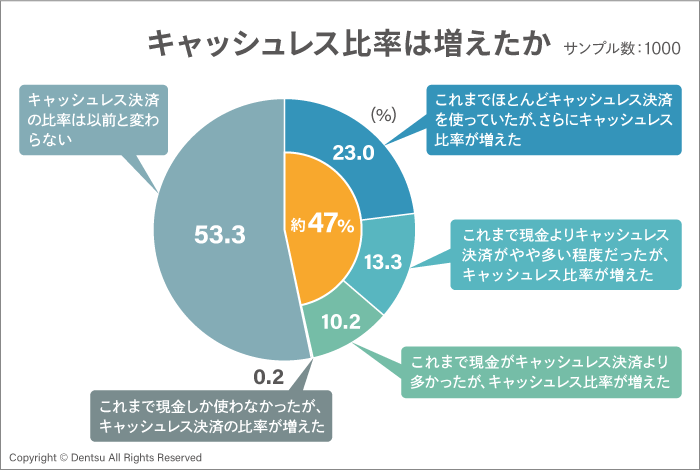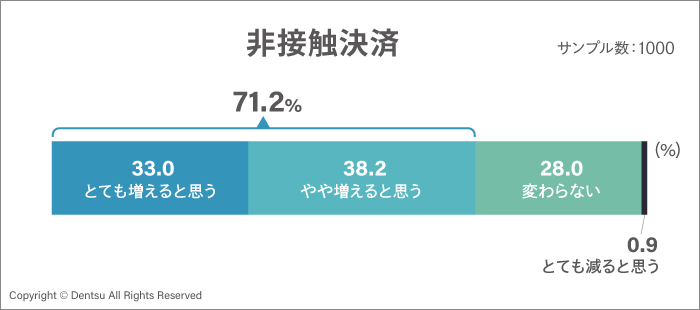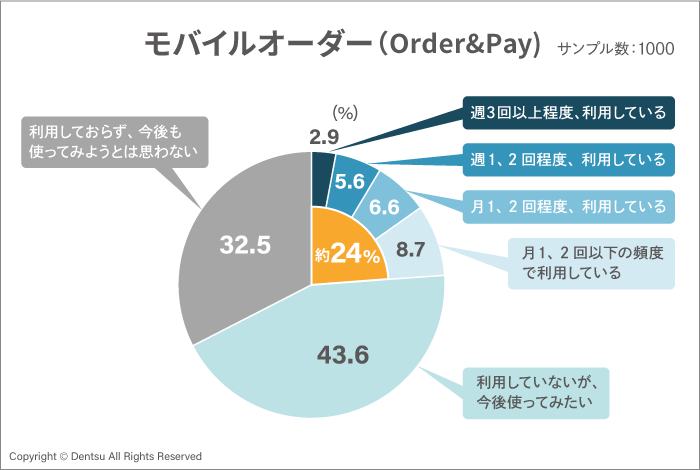Cashless payments themselves are now facing the need for transformation.
Amid the global spread of the novel coronavirus (COVID-19), Dentsu Inc. Cashless Project conducted a 'Cashless Awareness Survey' under the theme 'COVID-19 Impact and Shifts in Cashless Awareness.' How have consumers' payment methods changed due to the COVID-19 impact, and what will become mainstream going forward? This time, based on the survey results, we reveal shifts in consumers' attitudes toward cashless payments.
Approximately 50% report "increased cashless payment ratio" since state of emergency declaration
Since the state of emergency declaration, 46.7% of consumers reported that "the proportion of cashless payments for purchases and shopping has increased," indicating a rise in cashless payment usage.
While it was expected that the cashless ratio would increase among "cashless users," it is noteworthy that 10.2% of respondents stated, "I used cash more often before, but my cashless ratio has increased," indicating that even among "cash users," some have increased their cashless payments.

Top reasons for increased cashless payments: "Speed" and "Hygiene"
So, what are the reasons for the increase in cashless payments among consumers after the COVID-19 shock?
When asked the main reasons for increased cashless payments,
"Points and cashback are attractive" (76.8%)
"Because checkout is faster" (54.5%)
"It's clean/hygienic" (44.2%)
"Because online shopping and ordering have increased" (34.0%)
These were the top responses.
This shows consumers are utilizing cashless payments not only for the perceived value of "points and cashback" but also for reasons like "speed" and "hygiene."

A key term in virus infection countermeasures is "social distancing" (maintaining interpersonal distance). The top-ranked reasons of "speed" and "hygiene" clearly reflect consumers' heightened awareness of safety.
Social Distancing and Contactless
Amidst this, contactless payments (touch-based payments via cards, e-money, mobile devices, etc.) are gaining global attention as a faster and cleaner cashless payment method.
According to the latest survey results from a major credit card company (*), 79% of people worldwide use contactless payments for purchasing daily necessities, and 82% of people feel it is cleaner compared to other payment methods.
※Mastercard Global Consumer Study
An online survey of 17,000 people across 19 countries. Japan was not included in the survey. Survey period: April 10-12.
Regarding contactless payments, when asked "Do you think you will use them more often in the future?" in this survey, 71.2% responded "Yes," with approximately one in three respondents (33.0%) stating "I think I will use them much more often."


Although cashless payments are rapidly advancing in Japan, they are still considered low compared to other countries. Even within Japan, however, the need for contactless payments among consumers is rapidly increasing, driven by social distancing.
Trends in contactless services extend beyond payments
It's not just payments that are gaining attention due to social distancing. More people are using food delivery services as they refrain from going out.
Mobile ordering is gaining attention. This service allows customers to order items via smartphone, pay in advance, and then pick up the items in-store or have them delivered. It reduces contact with staff and eliminates the need for cash transactions.
Regarding mobile ordering, one in four respondents (23.9%) reported "using it." Including those who answered "would like to try it in the future," this accounted for about 70% of the total.
This growing interest in mobile ordering is also expected to provide a tailwind for promoting cashless payments, particularly mobile payments.
Can contactless become a driver for advancing a cashless society?
The survey results clearly show that cashless payments in Japan are steadily increasing following the COVID-19 shock.
This growth is underpinned by the COVID-19-driven "social distancing" trend, revealing an increasing number of consumers seeking safety features like "speed" and "hygiene" in payments. Coupled with shifting demand for contactless payment services and evolving consumption patterns like mobile ordering, signs of a paradigm shift in cashless awareness are emerging.
Consumers' lifestyles are expected to continue changing due to the COVID-19 shock. Against this backdrop, will contactless payments become a growth driver for Japan's cashless society? Furthermore, we will continue to observe whether they remain effective as a solution to the COVID-19 shock.
[Survey Overview]
◇Survey Method: Internet survey
◇Survey Period: May 30-31, 2020
◇Survey Area: Nationwide
◇Survey Participants: ① General consumers, ② Small and medium-sized enterprise (SME) owners
1,000 men and women aged 20–69 (weighted based on population composition)









